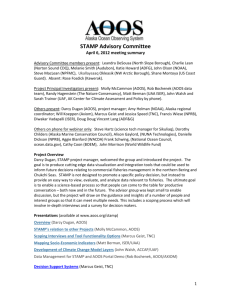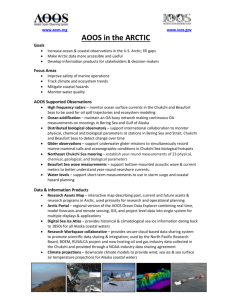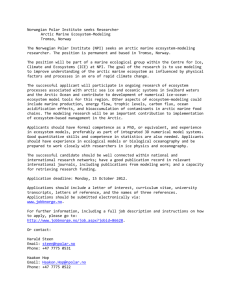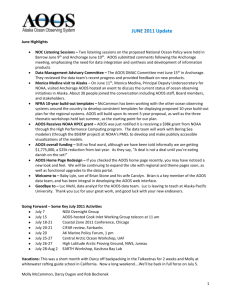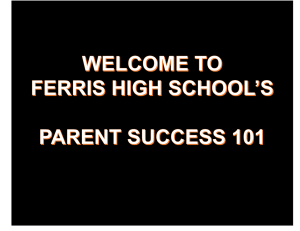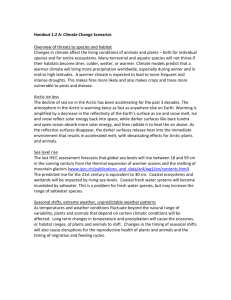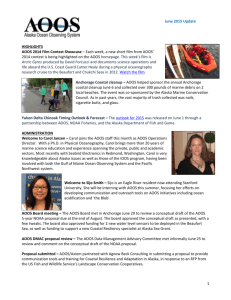STAMP Advisory Committee Sept 24
advertisement
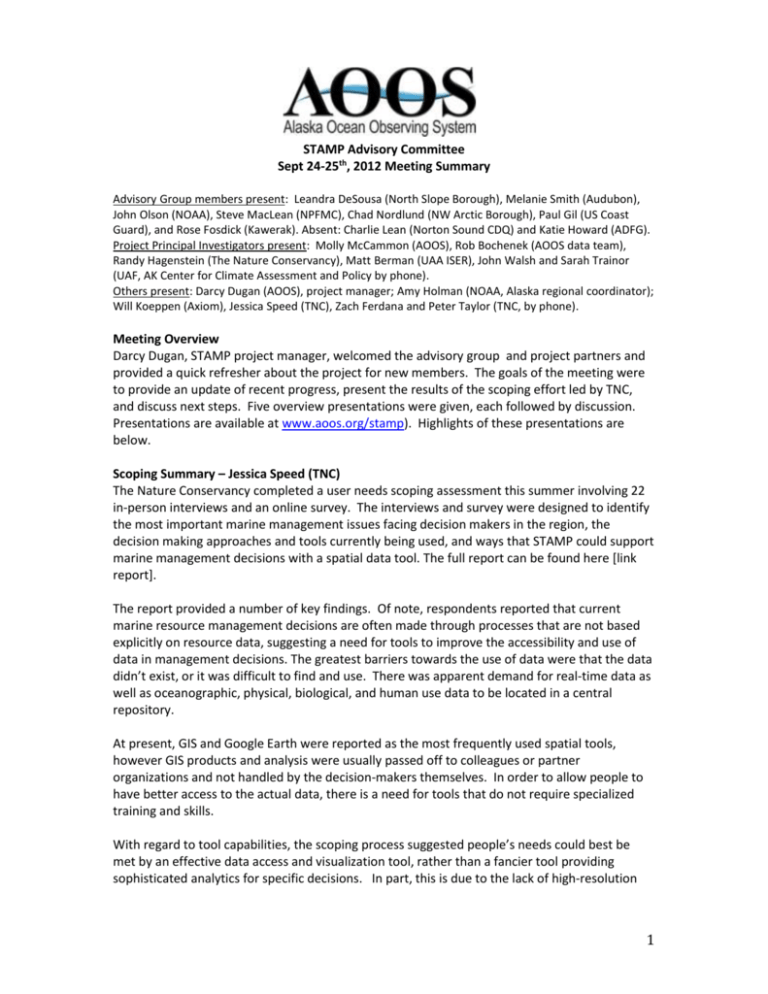
STAMP Advisory Committee Sept 24-25th, 2012 Meeting Summary Advisory Group members present: Leandra DeSousa (North Slope Borough), Melanie Smith (Audubon), John Olson (NOAA), Steve MacLean (NPFMC), Chad Nordlund (NW Arctic Borough), Paul Gil (US Coast Guard), and Rose Fosdick (Kawerak). Absent: Charlie Lean (Norton Sound CDQ) and Katie Howard (ADFG). Project Principal Investigators present: Molly McCammon (AOOS), Rob Bochenek (AOOS data team), Randy Hagenstein (The Nature Conservancy), Matt Berman (UAA ISER), John Walsh and Sarah Trainor (UAF, AK Center for Climate Assessment and Policy by phone). Others present: Darcy Dugan (AOOS), project manager; Amy Holman (NOAA, Alaska regional coordinator); Will Koeppen (Axiom), Jessica Speed (TNC), Zach Ferdana and Peter Taylor (TNC, by phone). Meeting Overview Darcy Dugan, STAMP project manager, welcomed the advisory group and project partners and provided a quick refresher about the project for new members. The goals of the meeting were to provide an update of recent progress, present the results of the scoping effort led by TNC, and discuss next steps. Five overview presentations were given, each followed by discussion. Presentations are available at www.aoos.org/stamp). Highlights of these presentations are below. Scoping Summary – Jessica Speed (TNC) The Nature Conservancy completed a user needs scoping assessment this summer involving 22 in-person interviews and an online survey. The interviews and survey were designed to identify the most important marine management issues facing decision makers in the region, the decision making approaches and tools currently being used, and ways that STAMP could support marine management decisions with a spatial data tool. The full report can be found here [link report]. The report provided a number of key findings. Of note, respondents reported that current marine resource management decisions are often made through processes that are not based explicitly on resource data, suggesting a need for tools to improve the accessibility and use of data in management decisions. The greatest barriers towards the use of data were that the data didn’t exist, or it was difficult to find and use. There was apparent demand for real-time data as well as oceanographic, physical, biological, and human use data to be located in a central repository. At present, GIS and Google Earth were reported as the most frequently used spatial tools, however GIS products and analysis were usually passed off to colleagues or partner organizations and not handled by the decision-makers themselves. In order to allow people to have better access to the actual data, there is a need for tools that do not require specialized training and skills. With regard to tool capabilities, the scoping process suggested people’s needs could best be met by an effective data access and visualization tool, rather than a fancier tool providing sophisticated analytics for specific decisions. In part, this is due to the lack of high-resolution 1 geographically comprehensive data that would be needed to run specific analytics. Additionally, people felt it was premature to tackle specific fisheries development-related decisions in this region (northern Bering and Chukchi Seas) – a view that was confirmed by the advisory group. It was also acknowledged that the issues and concerns relating to social acceptance surrounding commercial fisheries may be bigger than the biological questions at present. Based on the type of data currently available and interest in addressing broad-based research, planning and management needs, the Advisory Committee recommended development of a broadly-applicable data access and visualization tool. The scoping process showed high demand for the following attributes. These needs were also reinforced by the advisory group: A central clearinghouse that makes many types of data easily accessible User-friendly for people without special expertise High-quality data in a usable format and a variety of scales and resolutions Real-time data Fast downloads Ability to quickly add and visualize different types of data layers, such as relationships of shipping routes and wildlife habitats Multiple levels of access or interfaces for technical and non-technical users Include potential scenario-building tools Demonstration of Three “Outside” Portals – by Zach Ferdana and Peter Taylor,TNC To help provide insight into how other groups outside Alaska created decision support tools to meet their needs, Zach provided three examples and live demonstrations of tools with different contexts and final products. These were referred to often in subsequent discussions during the meeting. 1. Washington Marine Planner. This tool was developed subsequent to state legislation requiring marine planning. It serves as a data viewer which allows users to evaluate tradeoffs and extract information by using a scoring system for objectives, drawing areas to capture scores, and graphing multiple areas to compare relevance for different objectives. Link to portal: http://washington.marineplanning.org 2. MARCO – Mid Atlantic Ocean Data Portal. This tool was a collaboration funded by the mid Atlantic regional ocean council to meet the needs of a number of groups and states with different ideas of marine planning. It allows users to click on different topics and reveal the data layer options, clearly explaining what they are and giving the option to view on a map, read the metadata, download as kml, or visit the source. Link to portal: http://portal.midatlanticocean.org/portal/ 3. Coastal Resilience –This tool was developed for a single management objective, focusing on sea level rise and storm surge, and vulnerability planning/management. Link to portal: http://coastalresilience.org Each of these tools was built for specific management objectives. Peter emphasized the importance of identifying the management issues that STAMP would address when developing the specifics of the tool functionality. 2 Data Update – led by Rob Bochenek of Axiom (AOOS data team lead) Rob demonstrated the existing capacity of the AOOS Arctic Portal which is in development, and will serve as the foundation of the STAMP tool. The portal currently has several hundred layers including historical biological information in GIS format, as well as satellite-generated sea ice extent and model forecasts. Looking forward, Axiom will be working with other groups conducting Arctic data syntheses to share and display data as it becomes more integrated and visual. These include BOEM’s Synthesis of Arctic Research (SOAR), NPRB’s 1-year Arctic Synthesis, as well as many others. Additionally, Rob posed the idea of using the Ocean Workspace. The Workspace is a new online data sharing and collaboration tool that provides a centralized location for researchers to collate, aggregate and rapidly document scientific data sets/digital content and share these resources with project team members. Future Climate Projections – John Walsh and Sarah Trainor (ACCAP-UAF) ACCAP is continuing to develop downscaled climate model projections for temperature, precipitation, and wind for the Northern Bering and Chukchi region. The final output should allow users to explore thresholds and days of exceedance (e.g., comparing number of days the temperature may be over 10 degrees in a series of decades). There are many potential applications of this information for fisheries, shipping, and community planning, as well as potential impacts to currents, the sea ice edge, and ocean circulation. A big question is how to decide what the thresholds are. Social and Economic Data – Matt Berman, ISER ISER is compiling relevant social and economic data that can be added to the STAMP tool. Social and economic data is tricky since it can be difficult to map spatially, it’s hard to keep updated, and no two surveys are precisely the same. Three types of relevant data for this project are (1) human use of the marine environment; (2) social indicators of well-being; and (3) information on the built environment (infrastructure such as fuel, cold storage, housing, airports, ports, etc.). In some cases, ISER can provide the best avenue to procure these data sets. In other cases, they will work with the AOOS data team to assimilate them directly from the data source. MEETING DISCUSSION Discussion about Data Much of the data for this region is patchy (i.e., not region-wide), which is a challenge. However, patchy data is still useful – it helps inform permitting and NEPA processes, and also lets people know what has been sampled in the past. Because of the patchiness of the data, it’s important to find a clear and effective way to incorporate caveats into the tool that adequately describe the limitations of the data. Additionally, much of the data is of variable spatial and temporal resolutions, and has characteristics that make it useful for some purposes but not others. How do we create a tool that promotes the correct usage? o Ideas: Show the patchy data as a frame. If the data isn’t robust, don’t project the actual data, but point people to its location. Look at the CADIS example. o Address data gaps in a spatial way – often you can see presence but not absence. Make it a priority to accurately display both. o At times, it may be best to employ “effort mapping” instead of data mapping. 3 o Make sure the data matches the scale of the planning process. Is it close to the scale we need? Maybe not, but perhaps we can include it for now, and then look for ways to fill the data gaps. People want access to the latest data. The tool needs to be developed so it can be easily updated. How do we best incorporate local and traditional knowledge? Include as much fish data as possible (even if it’s patchy). There is currently limited funding to do the fish surveys in existing areas, and it’s unlikely the survey coverage will be expanding soon. Providing people good access to the existing fish data will be beneficial. Think carefully about how to handle and display synthetic data versus real data so that people can tell the difference. Representing real-time data, actual data, synthetic data, and the combination of actual/synthetic data in the same way can be misleading. Points Raised about Potential Tool Functions It’s difficult to develop something that both accesses all the data but still keeps it simple. People liked the idea of being able to draw a shape, and generate a report summarizing the data within the boundaries of the shape. Note: these analytics assume complete datasets. Allow users to change the legend, scaling and display. The ‘time slider’ option is key to helping show many years when no data was collected, but there needs to be more information about how best to use it. Incorporating the AOOS Ocean Workspace: people liked the idea of being able to connect raw data in the STAMP tool to experts who can help fill in gaps, or to other nonspatial contextual information. Creating avenues from the STAMP tool to relevant documents in the Ocean Workspace would be valuable. People would like to view or download data in both Albers AND polar projections. Make use of Facebook for project outreach – it’s used extensively in the villages. Including some “Special Capabilities” While realizing that a basic tool that increases access to available, synthesized data may best serve existing needs, the advisory group also discussed adding some special capabilities to include “decision-support” attributes in addition to data access and visualization. This would also demonstrate potential future capabilities if STAMP were to be expanded. Several ideas emerged. It was noted that most Arctic issues include some kind of vessel component (e.g., fishermen use boats of varying sizes; commercial shipping includes barges, tankers and other large vessels; offshore oil and gas operations rely extensively on boats to service rigs and other infrastructure.) One idea was to include a function to help design vessel traffic corridors , allowing people to draw and analyze their own corridors while looking at potential impacts to endangered or threatened species, fuel costs, marine safety, navigational hazards, etc. These could be linked to our climate model forecasts for the region. Incorporating sea ice was deemed important. Another idea was a gaming scenario with walrus, ice seals, ice flows, mobile habitat, and shipping. The specifics of this special function will continue to be discussed over the next few months, with the first priority on getting the data layers into the tool that could help us think about 4 scenarios. If the special tool function was to focus on a certain geographic region, the advisory group suggested using the Northern Bering since there was more data available for this region. Datasets to Pursue (biggest priorities in bold) ADFG data (salmon, marine mammals, forage fish, birds) Arctic Ocean Atlas (Audubon/Oceana) Arctic Synthesis (North Pacific Research Board) Bering Strait Port Access Route Study (USCG) Deep draft Arctic Port Study (USACE) Distributed Biological Observatory Environmental Response Management Application (ERMA) Geospatial Information Network of Alaska Historical AIS ship tracks (Marine Exchange of Alaska) Inuvialiq – Canadian datasets (?) Joint Industry Environmental Studies data (Shell, Conoco Philips, Statoil) Marine life studies and subsistence areas (North Slope Borough) NCEAS Cumulative impact layers– contact Ben Halperin OCSEAP historical data Pelagic surveys done by NMFS since 2002 RUSALCA Salmon, subsistence, and marine mammal data (ADFG) Sea ice forecasts (NWS) Sea ice atlas, historical (UAF) ShoreZone imagery and data State of Alaska Agency (other DOT, DEC, DNR data…) Stock assessments, endangered species, habitat, subsistence (NOAA fisheries) Subsistence mapping (Northwest Arctic Borough, NSB, Steve Braund & Assoc.) Synthesis of Arctic Data (NSF) Vessel Observer surveys Water quality sampling (DEC’s EMAP program) World Wildlife Fund’s ARKgis projects Next Steps: TNC is producing a report on relevant decision-support tools used elsewhere and their potential applicability to Alaska users. This will be released in November and circulated to the advisory group. Axiom will continue to pursue the priority datasets and add them to the Arctic Portal. AOOS will host a telecon/webinar with the advisory group before the holidays to provide an update on current progress. The topic of the “special function” of the tool will be raised again, once more data has been ingested. A date will be set for a spring stakeholder workshop on decision support tools, inviting a broader audience and allowing people to explore and discuss the existing STAMP platform. This meeting summary and other materials can be found at http://www.aoos.org/stamp/. For feedback or suggestions, please email Darcy Dugan at dugan@aoos.org. 5
